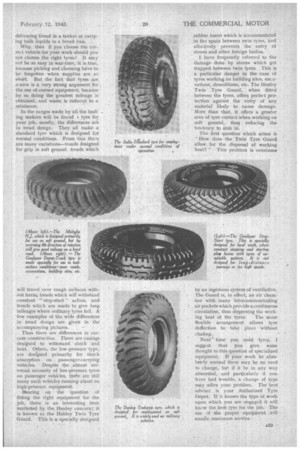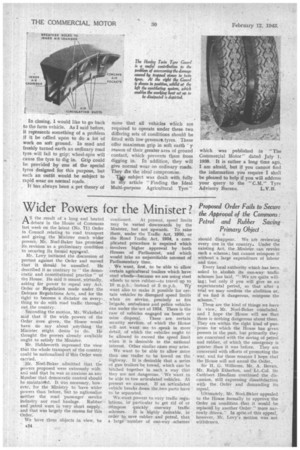HOW Tyre Mileage is Wasted
Page 24

Page 25

Page 26

If you've noticed an error in this article please click here to report it so we can fix it.
No. 19.—Specialized Operating Conditions Widely Different Working Conditions Call for the Use of Equipment Built for the Job, so as to Ensure the Greatest Safety and Economy
THERE is a vast.difference in the conditions under which vehicles are operated, and these are reflected in their effect on the tyres. Take, for instance, a baker's van delivering bread. Its job is local; the vehicle runs mostly on smooth roads and at speeds which are necessarily low, because most of the time is spent in built-tip areas. Every few yards the brakes are applied as house-to-house deliveries
are made. .
Contrast that kind of work with that of the long-distance haulier. The haulage man usually loads his vehicle to its utmost, then sets off on a 150-mile journey, which he tries to cover In a minimum of time. This is a very different .proposition from the local " pottering " of the baker's van. Loads are heavy; speeds are high and are maintained over long distances; brake application is hard and frequent by reason of the speed; great heat is built up in the tyre.
Worst Possible Conditions
Then, again, consider the " roughhaulage " contractor—the type who caters mainly for the demolition, building, and scrap trades. Most of the journeys of his vehicles are local, but they are carried out under the worst possible conditions. The usual scenes of operations are quarries, building sites, unmade roads, tips, scrap-yards, etc. Here the tyres are driven over brickbats, glass, scrap metal, flints and the like, all of which add their quota of damage. On top of all this, there is a tendency • towards serious overloading in • this class of work. More tyre trouble is experienced by these operators than by all the others put together. Their
. working conditions are almost unfit for the employment of pneumatic tyres. . .
Consider, too, the farm vehicle. It works under conditions compiising a •
mixtureof deep, yielding mud and loose, flinty, coiintrk roads. The tyres are expected to support the vehicle through both conditions.
Then, proceeding to passenger vehicles, look at the difference in operating conditions between a longdistance bus and a local one.
Where, you may ask, is all this leading? Simply this, that it is obvious all these varying conditions call for different types of tyre. It is impossible to combine all the essentials into a single all-round tyre because, often, the demands of the different classes of work are conflicting. , The baker, for instance, needs a • tyre which will withstand constant stopping and starting, because this is about the most, serious stress that his, tyres have to withstand. Heat is of no cimsequence, because the moderate speeds that are maintained do not generate high temperatures.
The long-distance haulier, first and foremost, requires a• tyre designed to withstand the heat which develops from long journeys at high speeds with maximum loads—quite a differ-' ent proposition from the baker.
The " rough-haulage " contractor is not worried. much by heat, nor by stopping and starting. His chief need is for a tyre which is tough enough to resist the entry of foreign bodies and which will suffer the minimum of harm while being run ov abrasive surfaces. He wants a tread pattern which will. refuse to pick up flints, glass, etc.
The farmer is quite a problem. He requiresa tyre which will give grip in soft ground and yet will offer resistance to wear on rough country roads. The problem lies in the fact that good grip and resistance to abrasion do not go together. Grip is usually achieved by a tread pattern offering considerable friction. Such a design will last well in soft ground, but its rate of wear is rapid when the tyre is run on country roads.
Passenger-vehicIe Problems
Finally, there is the comparison between longdistance and local passenger vehicles. Naturally, the 'conditions of operation are more or less analogous to the long-distance haulier and the baker, but in this case one of the primary considerations is the comfort of the passengers. Thus, we need the aforementioned characteristics, but applied, this time, to a low-pressure rather thanto a high-pressure tyre.
I think all that has. been said should make it clear that the universal all-round tyre is a father Utopian idea. Tyre manufacturers have realized this for some time, and most of them have a wide variety of types to cope with the different conditions of operation. It is regretful that tyre users do not take fuller advantage of the facilities that are offered. Obviously, it is infinitely better to have a tyre which is properly fitted for a specific job than to use one which was really intended for other work. It is a case of specialization.
If you are doing specialized work you need specialized equipment. Specialized vehicles are used in mane spheres, so Why not specialized tyres? You would not think of buying a Luton-tyPe "hat-van" for carrying bricks any more than you -would deliver hats on a short-wheelbase tipper. You would not think at
delivering bread in a tanker or carrying bulk liquids in a bread van.
Why, then if you choose the correct vehicle for your work should you not choOse the right tyres? It may not be so easy in war-time,it is,trut, because picking and choosing have to be forgotten when supplies are so short. But the fact that tyres are scarce is a very strong argument for the use of correct equipment, because • by so .doing the greatest mileage is obtained, and waste is reduced to a minimum.
In the ranges made by all the leading makers will be found s. tyre for your job, mostly, the differences are in tread design. They all make a standard tyre which is designed f.zr normal conditions. From this there_ are many variations—treads designed for grip in soft ground treads which will travel over rough surIaces without harm., treads which will withstand constant " stop-start" action, and treads which are made to give long mileages where ordinary tyres fail. A few examples of the wide differences in tread design are given in the accompanying pictures.
Then there are differences in carcase construction. There are casings designed to withstand shock and heat. Others, the low-pressure type, are designed primarily for Shock absorption on , passenger-carrying vehicles. Despite the .almost universal necessity of low-pressure tyres on passenger vehicles, thete are still many such vehicles running about on, high-pressure equipment.
Dearing on the question of fitting the right equipment for the job, there is an interesting item marketed by the Henley concern ; it is known as the Henley Twin Tyre Guard. This is a specially designed rubber insert which is accommodated in tIK: space between twin tyres, and effectively prevents the entry of stones and other foreign bodies.
I have frequently referred to the damage done by stones which get. trapped between twin tyres. This is a particular danger in the case of tyres working on building sites, excdvations, demolitions, etc. The Henley Twin Tyre Guard, when :fitted between the tyres, offers perfect protection against the entry of any material likely to cause damage. More than that, it offers a greater area of tyre co,ntact.when working on soft ground, thus reducing the tendency to sink in.
The first question which arises is " How does the Twin Tyre Guard allow for the dispersal of working heat? " This problem is overcome
by an ingenious system of ventilation. The Guard is, in effect, an air .cham-ber with many intercommunicating Air pockets which provide a continuous circulation, thus dispersing the work
ing heat of the tyres. The same flexible arrangement allows tyre deffection to take place without chafing.
Next time you need tyres, I suggest that you give some thought to this.questinn of specialized equipment.. If your work be absolutely normal there may be no need to change, but if it be in any way abnormal, and particularly if you h-tve had trouble, a change of type may sdlve your. problem. The best adviser is your Authorized Tyre Depot. If it knows the type of work upon which you are engaged it, will kn.-tw the heft tyre for the job. The use clf the proper equipment
ensue maximum service. In closing, I would like to go back to the farm vehicle. As I said before, it represents something of a problem if it be called upon to do a lot of work on soft ground. In mud and freshly turned earth an ordinary road tyre will fail to grip; wheel-spin will cause the tyre to dig in. Grip could he provided by one of the special tyres designed for this purpose, but such an outfit would be subject to rapid wear on normal roads.
, It has always been a. pet theory of mine that all vehicles which are required to operate under these two differing sets of conditions should be fitted with low-pressure...tyres. These offer maximum grip in soft earth' y reason of their greater area of ground contact, which prevents them from digging in. In' addition, they will give normal wear on ordinary roads. They a're the ideal compromise.
Tis. subject was dealt with fully in my article "Finding the Ideal Multi-purpose Agricultural Tyre"
which was published in '` The Commercial Motor" dated July 1, 1938. It is rather a long time ago, I am afraid, but if you cannot find the information you require I shall be pleased to help if you will address your query to the " C.M." Tyre Advisory Bureau. L. V. B




























































